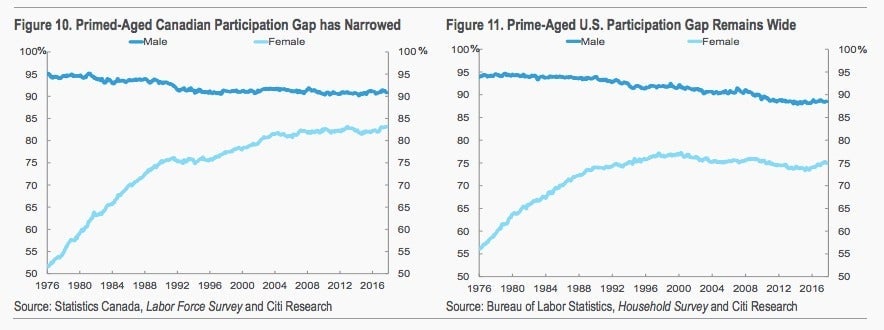Why are so many more women working in Canada than the US?
Canada and the US have a lot in common—they share a long border, language (for many people), and exchange pop culture. But when it comes to jobs, Canadian women are much more likely to be in the workforce than their US counterparts. Three decades of public policies and business incentives may explain the difference, according to a new report by Citigroup.


Canada and the US have a lot in common—they share a long border, language (for many people), and exchange pop culture. But when it comes to jobs, Canadian women are much more likely to be in the workforce than their US counterparts. Three decades of public policies and business incentives may explain the difference, according to a new report by Citigroup.
The countries had similar levels of male and female labor force participation in the 1990s, but improvement has generally continued in Canada even as it has stalled in the US. In particular, more women are working in the northern nation and they work more hours each day, even though they’re more likely to be part time, according to Citigroup.
Making sure the workforce is fair and rewarding for women benefits everyone. Reducing gender inequality could boost economic growth by about 6% for advanced economies in the coming decades, according to the bank’s economists. Countries that have higher labor force participation for women tend to have a more robust employment market for men as well.
“Over the next decade, the impact of women on the global economy will be at least as significant as that of China and India’s respective one-billion plus populations, if not more so,” Tina Fordham, Citigroup’s chief global political analyst, said in the report.
What’s Canada’s secret? For one thing, there’s a greater availability of full-time jobs in the country’s private sector, and those roles tend to be higher paying. Tax reforms, according to Citigroup, have also helped: Replacing income tax deductions on secondary earners with tax credits encouraged secondary earners—usually women—to work. Canada’s federal government also provides benefits and tax cuts for families with kids and has tax credits for caregivers. In the US, the Trump administration is considering similar reforms in its tax plan.

Policies at the federal and provincial level in Canada are designed to support parenting and child development: In 2001, Canada’s maternity and parental leaves were increased to 52 weeks, from 27 weeks. It also has a national system of child care and early learning that the government helps pay for.
Workers in Canada’s federally regulated sectors are assured equal pay and the current government is looking to strengthen those guarantees, according to Citigroup. The country’s employment insurance benefits have been expanded to new mothers as well as other caregivers.
The US is further behind on such measures, according to Citigroup—the world’s largest economy has fewer federal mandates that support equal pay, less public investment in things like day care facilities, and the tax regime tends to penalize married couples. The 1996 Welfare Reform Act managed to boost labor participation among single mothers, but Citigroup says the public benefits “were rendered more temporary and conditional.”
Many big economies like the US could unlock greater growth and boost participation from women in the workforce “simply by following best practices already adopted by some countries, such as Canada,” said Andrew Pitt, global head of Citigroup research.